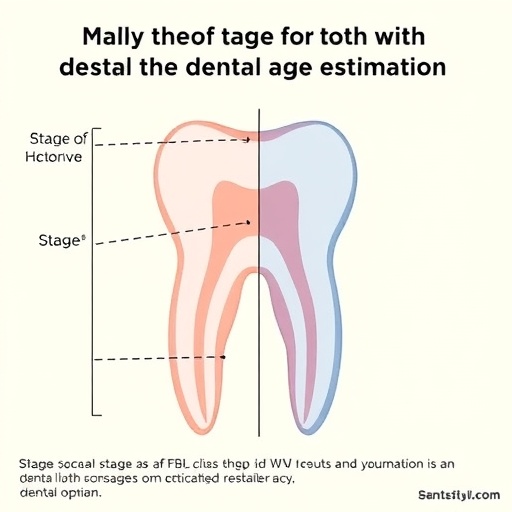In the dynamic field of forensic science, precise and reliable age estimation methods remain a cornerstone for investigations ranging from identification of unknown individuals to legal age assessments. A groundbreaking study recently published in the International Journal of Legal Medicine sheds new light on dental age estimation techniques, focusing on the London Atlas as a pivotal tool. The research, conducted by Tan, Davies, and Liversidge, delves into which specific tooth and tooth development stage serve as the most accurate predictor of chronological age, deliberately excluding the often-variable third molars from analysis. This critical refinement reflects a growing trend towards increasing precision and applicability in forensic odontology.
Until now, the third molars – commonly known as wisdom teeth – have traditionally played a significant role in age estimation practices, despite their notorious variability in development and eruption timing. The exclusion of these teeth marks a significant shift in methodological rigor, addressing longstanding concerns over their reliability. Instead, the research directs attention towards other dentition, exploring the detailed stages of dental maturation across various teeth to discern which hold the strongest correlation with a person’s true age. Their findings are poised to revolutionize forensic protocols, offering practitioners a more refined guide when assessing younger individuals or those without fully erupted wisdom teeth.
The London Atlas, a comprehensive dental development chart, is central to this study. It maps the typical progression of tooth formation stages across age cohorts, providing a visual and categorical reference for forensic analysts worldwide. By deploying this atlas and rigorously analyzing multiple tooth types, the researchers were able to identify patterns that transcend individual variability and biological noise, capturing robust indicators of age progression. The methodical approach involved assessing the developmental stages of teeth across a large cohort, correlating these observations with precisely known ages to generate authoritative benchmarks.
.adsslot_253OQhAZkl{ width:728px !important; height:90px !important; }
@media (max-width:1199px) { .adsslot_253OQhAZkl{ width:468px !important; height:60px !important; } }
@media (max-width:767px) { .adsslot_253OQhAZkl{ width:320px !important; height:50px !important; } }
ADVERTISEMENT
A pivotal insight of this research concerns the specific tooth and associated growth phase that emerge as the best age predictors. The study revealed that particular premolars and canines, when evaluated at defined stages of root and crown development, exhibited the highest predictive accuracy. This is a transformative revelation since previous methodologies often generalized across multiple teeth or over-relied on less stable indicators. By pinpointing exact loci within the dental formation process, forensic experts gain an unprecedented level of specificity, reducing error margins and enhancing confidence in age estimations.
Beyond the forensic implications, these findings carry substantial ramifications for medico-legal contexts where accurate age determination can influence judicial decisions, immigration status, and child protection services. In many jurisdictions, being able to determine whether an individual is a minor or adult has significant legal consequences. However, the inherent biological variability in tooth maturation has historically complicated such determinations. The refined approach introduced here helps bridge that gap, offering evidence-based tools that are less vulnerable to inter-individual differences, potentially reshaping legal frameworks reliant on forensic age estimation.
The study’s exclusion of third molars – a route less traveled in prior research – holds particular significance. Wisdom teeth can begin development as late as the teenage years and often present anomalous timelines, with some individuals exhibiting early eruption and others retaining unerupted or absent third molars well into adulthood. Their high variability has frequently undermined drone-like forensic age estimates, culminating in inconclusive or debated findings. By focusing instead on more stable teeth less prone to such erratic growth patterns, Tan and colleagues prioritize consistency and reliability over convention.
This research is underpinned by rigorous statistical modeling, leveraging regression analyses and cross-validation techniques designed to ensure robustness and generalizability. By systematically comparing the dental age estimations derived from individual teeth against known chronological ages, the study was able to quantify prediction errors and determine the peak predictors with unparalleled precision. The authors emphasize that the highest degree of accuracy was not only achieved by selecting the right tooth, but by identifying the optimal developmental stage for assessment—highlighting the nuanced intersection of dental anatomy and chronological progression.
Moreover, the implications extend to global populations often underrepresented in forensic databases. Age estimation models traditionally developed on limited or ethnically homogeneous samples lack universal applicability, raising ethical and practical concerns about biased outcomes. Although this study focuses primarily on data calibrated from London-based cohorts, the methodological framework introduced lays the groundwork for tailored atlases fit for diverse populations. Future research building on this foundation could rectify disparities in forensic age estimation practices worldwide.
The accompanying depiction—part of the original published work—illustrates dental stages correlated with age, effectively encapsulating the crux of the investigation. The visual representation within the London Atlas shows development markers for teeth such as incisors, canines, and premolars across various chronological age ranges. Such clarity in visualization empowers forensic professionals to translate complex biological timelines into accessible age estimates quickly and reliably, significantly aiding fieldwork and courtroom presentations alike.
The precise determination of age also intersects with anthropological and archaeological sciences, where understanding population dynamics, growth patterns, and health trajectories of past human groups often hinges on dental development studies. The improved predictability highlighted in this research may not only solve modern forensic puzzles but also unlock new insights into historical populations, childhood health, and evolutionary biology by enabling more accurate reconstructions of age-at-death from skeletal remains.
Despite the advancements offered by Tan, Davies, and Liversidge, the study acknowledges the inherent challenges that persist in age estimation. Biological variability, environmental factors, and nutritional influences can all subtly modify dental maturation tempos. As such, while the focus on specific teeth and stages improves estimative power, forensic professionals are encouraged to use these methods in conjunction with other biological markers and contextual data. Cross-disciplinary approaches will always remain the gold standard for comprehensive and justifiable age assessments.
The methodology also brings to light the evolving interfaces between traditional forensic practices and emerging computational tools. Machine learning and artificial intelligence hold promise for automating the categorization of dental stages and the large-scale analysis of dental datasets, potentially streamlining the age estimation process. Future integration of these techniques with the London Atlas framework could enhance throughput and minimize observer bias, democratizing forensic odontology expertise and increasing accessibility in resource-limited settings.
Crucially, the study underscores the London Atlas’s adaptability and longevity as a forensic resource. Originating as a remarkable synthesis of dental maturation data, it continues to evolve through empirical testing and technological augmentation. The fine-grained insights from this current research reaffirm the atlas not only as a historical document but as a living tool, continually refined to meet contemporary demands for forensic accuracy, transparency, and applicability.
Legal medicine and forensic science communities stand to benefit immensely from these findings. The ability to pinpoint which teeth and which developmental stages are the most reliable markers equips practitioners with validated, evidence-backed strategies to support age determination conclusions in a variety of cases. Signal improvements in accuracy can translate directly into stronger, more defensible expert testimony, reducing disputes and reinforcing the role of dental science at the interface of medicine and law.
Looking ahead, ongoing research will likely meld biological measurements with biochemical markers such as enamel proteins or DNA methylation patterns to further refine age estimates. The work performed by Tan and colleagues serves as a pivotal benchmark, setting standards against which these frontier technologies can be compared and integrated. By enhancing the anatomical understanding of tooth development, they provide a critical scaffold that supports the future convergence of traditional morphology and molecular forensic science methods.
In conclusion, this seminal study redefines dental age estimation by systematically eliminating unreliable data points and spotlighting the most telling teeth and maturation stages. This leap forward is poised not only to sharpen forensic investigations but also to provide a more equitable and scientifically sound basis for legal determinations worldwide. In an era increasingly driven by precision medicine and data transparency, such research exemplifies how methodical refinement of established tools can unlock new horizons in applied science and human rights protection.
Subject of Research: Dental age estimation accuracy using the London Atlas, focusing on which tooth and tooth development stage best predict chronological age, excluding third molars.
Article Title: Dental age estimation using the London atlas– which tooth and which tooth stage predict age best (excluding 3rd molars)?
Article References:
Tan, WX., Davies, J.A. & Liversidge, H.M. Dental age estimation using the London atlas– which tooth and which tooth stage predict age best (excluding 3rd molars)?.
Int J Legal Med (2025). https://doi.org/10.1007/s00414-025-03557-4
Image Credits: AI Generated
Tags: age estimation protocols in legal contextschronological age prediction methodsdental maturation stagesexclusion of third molarsforensic dental age estimationforensic odontology advancementsLondon Atlas in dentistryprecision in age assessmentreliable age estimation techniquessignificance of dentition in forensicstooth analysis for age determinationtooth development stages






